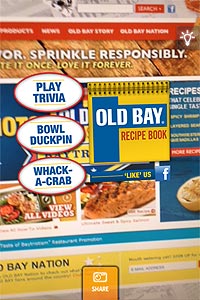Commentary
Old Bay Seasoning Almost Gets Me To Play With My Food The AR Way
- by Steve Smith , Staff Writer @popeyesm, August 3, 2012
 Augmented Reality is likely to be the mobile marketing gadget du jour this year as many brands and agencies look for ways to “engage” (we’ll regret the day
we ever invented that word) consumers with physical products.
Augmented Reality is likely to be the mobile marketing gadget du jour this year as many brands and agencies look for ways to “engage” (we’ll regret the day
we ever invented that word) consumers with physical products.
The basic logic is sound. A QR code is a nice intermediary for getting someone to aim their phone cam at your signage or package. But in the end you more likely want them to interact directly with the logo and package art that you want emblazoned on their memory. AR has the inherent strength of virtualizing touch and feel.
There are different types of AR, of course. There is the more sophisticated synchronized overlay, where 3D objects actually come to life atop a given object and create a truly interactive version of the 2D experience. Early AR enhancements of Lego packaging are a good example of this done well. The 2D package object would come to life and assemble itself out of Lego pieces. Both Nintendo’s 3DS and PlayStation’s Vita handheld game consoles have come with truly interactive AR games that are rudimentary but promising.
The other use of a kind of low-level AR really is just image recognition used as a trigger for some separate mobile event. That seems to be the approach that many marketers now are using with product packaging and print ad units. AR becomes a less ugly stand-in for QR.
That is pretty much the way Old Bay is using AR in its new campaign with provider Blipper. You aim the Blipper app at an Old Bay logo of any kind (we used the Web site) and it triggers a menu of games and interactions. The effect is cool enough because the experience remains in your camera view, so it seems to be removed from the typical Web site or app setting. Still, there is nothing especially “augmented” about it.
Regardless of the trigger, it still all comes down to execution, where this attempt is decidedly uneven. An Old Bay logo brings up a good-looking menu that allows you to go through disposable and gratuitous games. We like that the games themselves are all in the brand spirit of old seafaring culture. But Whack a Crab and Duckpin Bowling are so frustrating because of poor responsiveness that most consumers will ditch them. The Baltimore trivia is fine. The real heart of the gadget is the recipe book that the package activates. Here you can literally flip through ideas and click into downloadable recipes. This is a functionality that is useful and fun to use.
The problems come in when interacting with the app itself. Virtually every action you take off of the AR trigger kicks you to a Web event that seems to reset the Blipper app when you return to it. I thought that tapping the bright lightbulb in the corner of the screen was saving my Old Bay bookmark for repeat interactions, but it didn’t.
In the end, the pieces of a good experience were here. In fact, this starts off with a nice promise of a good payoff for my efforts. But generally the pieces were not knit together into something pleasant and seamless. Instead, I was fighting the app and the interface to get to the good idea somewhere in here.
In the long run, I just can’t imagine that brands will want to redirect users to third-party apps the consumers never heard of in order to interact with their brands. Just as 2D mobile codes have started to migrate into general shopping apps and branded magazine apps, I imagine we will start to see AR embedded in brand apps. But AR is where QR was a few years ago. We need to get beyond relying on the wizardry of it all and realize that people will be turned away from this method of interaction if they aren’t getting effortless experiences.



